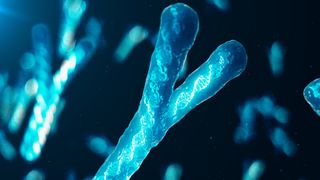At several points in our complex history, modern humans have mated with Neanderthals.
This left a telltale signature in the genomes of today’s modern humans, and this Neanderthal DNA impacts our health in multiple ways.
However, there is a part of our genome devoid of Neanderthal DNA: the Y chromosome. But why?
Experts told Live Science that this could partly be due to chance. But it is also possible that the genes of Neanderthals were incompatible with those of women. A wise man wear them. This would mean that only female hybrids would be able to reproduce.
Related: Neanderthal woman’s face comes to life thanks to stunning reconstruction
The “Y” that disappears
The Y chromosome is one of two types of sex chromosomes in humans. Women carry two copies of the X chromosome, while men carry one X and one Y chromosome. The Y chromosome cannot be passed on from father to son.
At first, scientists analyzed DNA extracted from the fossilized remains of Neanderthal women. However, in 2016, a study published in the American Journal of Genetics examined a Neanderthal Y chromosome from a 49,000-year-old Spanish man.
“We have never observed Neanderthal Y chromosome DNA in any human sample ever tested,” Carlos Bustamanteco-senior author of the study and a population geneticist at Stanford University, said in a statement. statement at the time.
So why did this Neanderthal DNA seemingly disappear without a trace?
Perhaps the simplest answer is that it was lost from the human gene pool over thousands of years.
“The amount of Neanderthal DNA in modern humans today is relatively small and may therefore have been lost through drift,” Fernando Mendezlead author of the study, who was a postdoctoral researcher at Stanford at the time, told ABC News. In other words, it is not that Neanderthal DNA was less “fit” than modern human DNA from an evolutionary perspective, but rather that it was simply lost with time.

Another possibility is that the Neanderthal Y chromosome was incompatible with our own DNA. For example, the team discovered that three of the Neanderthal Y chromosome genes, different from those found in humans, function as part of the Y chromosome. immune system. These genes allow the immune system to differentiate friends – that is, the body’s own cells – from enemies. The inability to correctly distinguish “self” from “invader” explains why tissue transplants from men to women can be rejected or why a mother’s immune system can attack a male fetus during pregnancycausing a miscarriage.
Related: ‘It just didn’t work’: Mating between Neanderthals and modern humans could be the product of failed alliances, says archaeologist Ludovic Slimak
It is therefore conceivable that the immune systems of modern women systematically attacked male babies carrying Neanderthal DNA on their Y chromosome, leading to repeated miscarriages and ultimately the loss of Neanderthal Y genes.
If modern women who interbred with Neanderthals had fewer boys than other couples, then consistently the boys who lived were likely to have fewer boys, Mendez says. told ABC News. This hypothesis aligns with an old theory called “Haldane’s rule,” which suggests that if reproduction between genetically different populations leads to infertility, it is likely to be in the sex – in this case, male – that carries two different sex chromosomes.
A considerable loss
This is not the first time in our evolutionary history that the Neanderthal Y chromosome has failed to compete with its modern human counterpart.
Between 550,000 and 765,000 years agothe population that would give birth to A wise man diverged from Neanderthals and another group of now-extinct human relatives called Denisovans.
However, a study published in the journal Science in 2020 revealed that between 370,000 and 100,000 years ago, Neanderthals and early modern humans interbred. 100,000 years ago, the Neanderthal Y was completely replaced by that of A wise man.
Scientists don’t know why this happened. Martin Pierreco-lead author of the study, a researcher and programmer at the University of Copenhagen in Denmark, told Live Science.
But one likely explanation, Petr hypothesized, is that for hundreds of thousands of years, Neanderthals had a very small population compared to early modern humans. The small population size allows harmful mutations to accumulate in the gene pool at a higher rate than in a larger population, he said.
If you then introduce “healthier” modern human DNA into the mix, natural selection would favor that modern human DNA, which then swept through the Neanderthal population.

However, without much more genomic data on Neanderthals that would allow scientists to study the functional impact of inheriting this modern human DNA, this is only a hypothesis, Petr said.
Related: Scientists finally solve the mystery of why Europeans have less Neanderthal DNA than East Asians
Many unknowns
Unfortunately, it is still too early to say with certainty why Neanderthal Y DNA was lost in these two cases, Adam Siepela computational biologist at Cold Spring Harbor Laboratory in New York, told Live Science in an email.
It’s still possible that the replacement was due to random genetic drift, he added.
Neanderthal DNA lives in us
Generally speaking, the loss of a Y chromosome lineage due to interbreeding is not a rare phenomenon, Carles Lalueza-Foxco-author of the Science 2020 study and a paleogenomics researcher at the Institut de Biologia Evolutiva in Spain, told Live Science in an email.
This is because the Y chromosome is only inherited paternally, he explained. This is in contrast to other chromosomes in the body which are passed on to the next generation by both parents. This means the Y chromosome is more likely to be “lost” over time, he said.
Have you ever wondered why some people build muscle more easily than others Or why freckles appear in the sun? Send us your questions about how the human body works community@livescience.com with the subject line “Health Desk Q,” and you may see the answer to your question on the website!